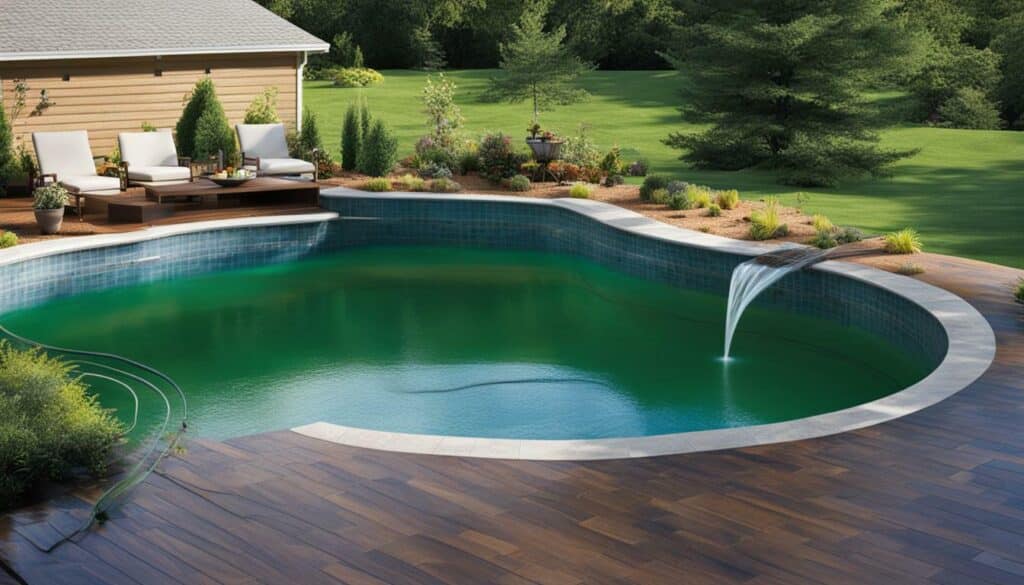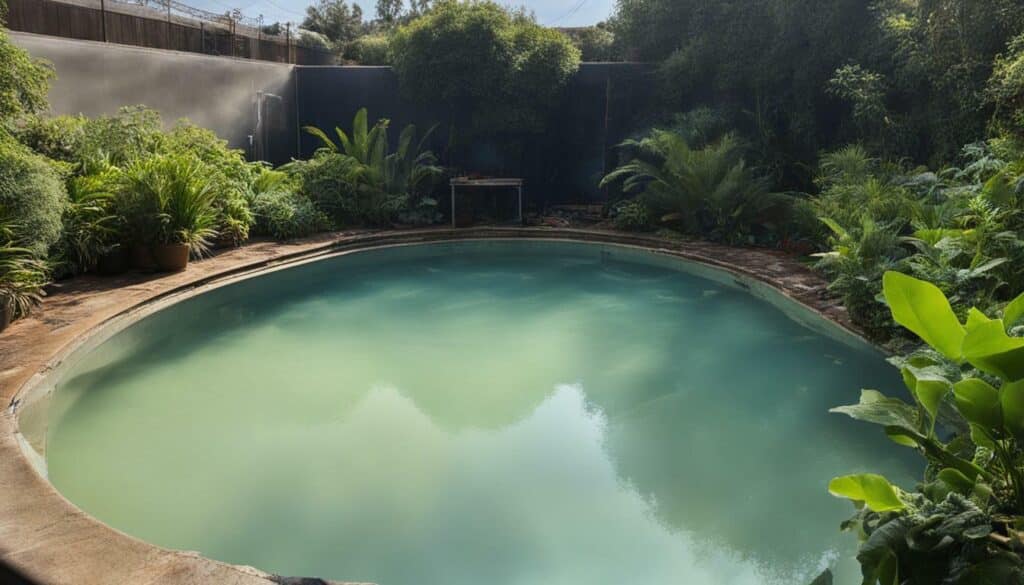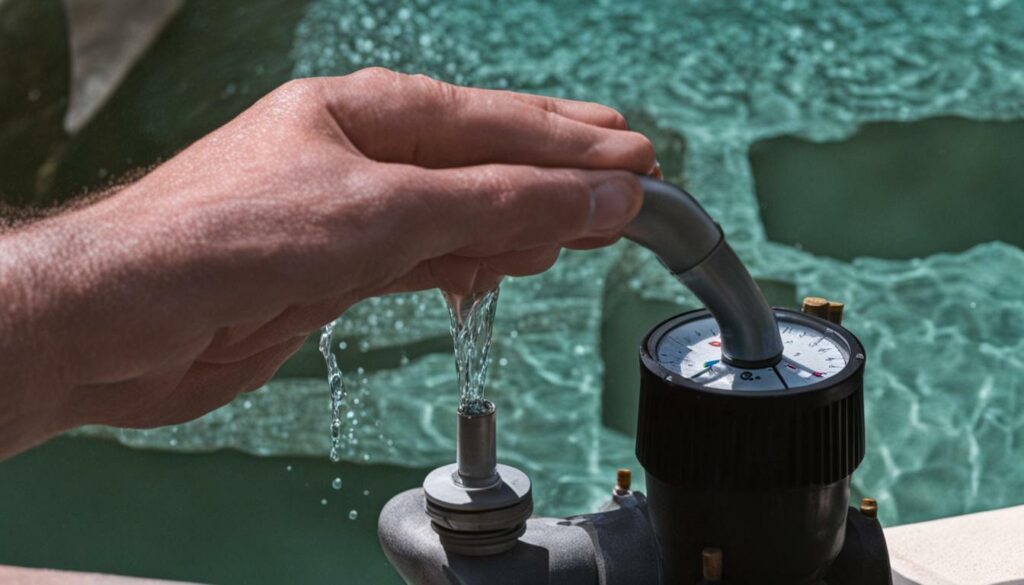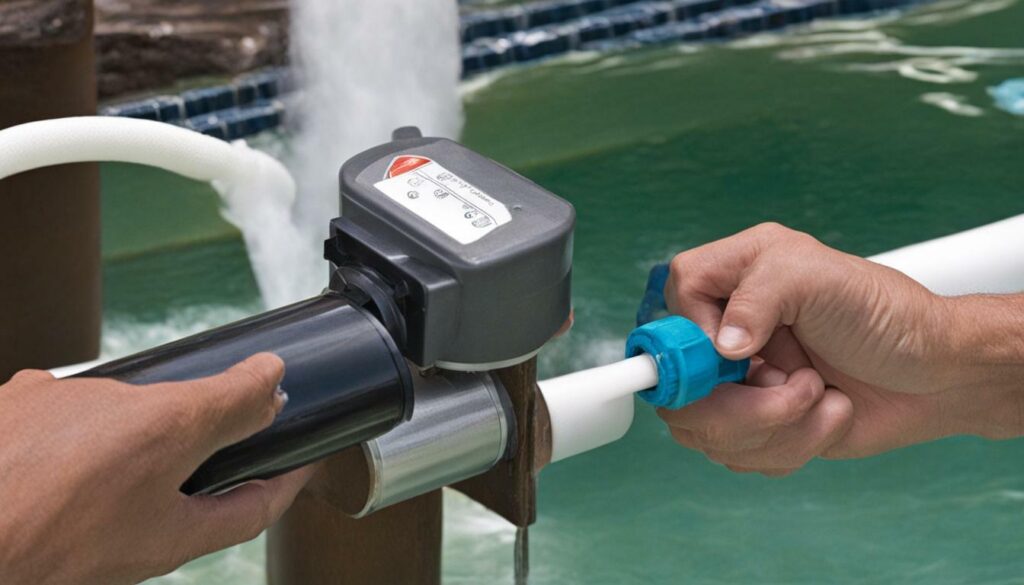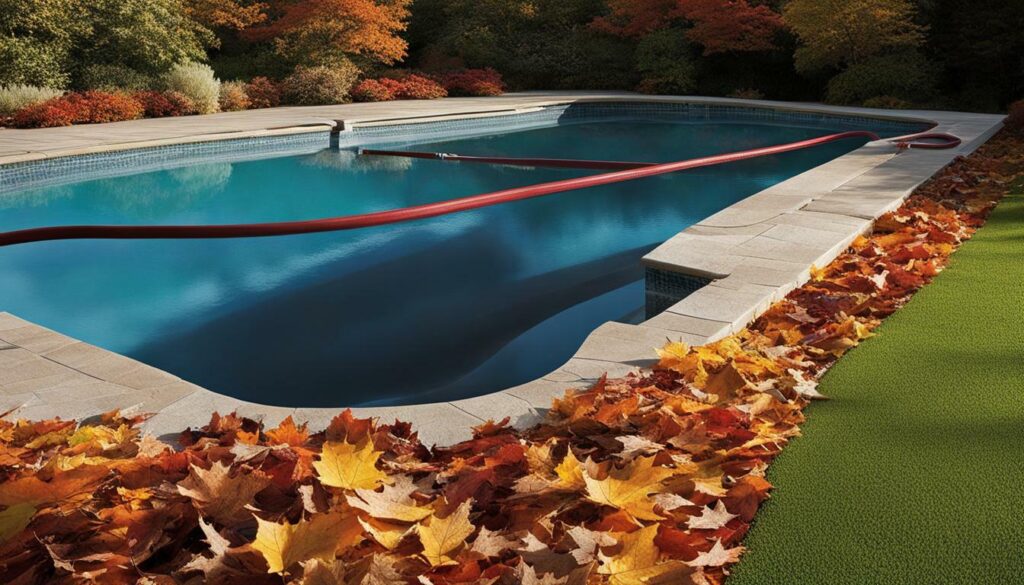
Properly draining your above ground pool is an essential part of pool maintenance. Whether you’re preparing your pool for winterization or dealing with water quality issues, knowing how to drain your pool can ensure its longevity and quality.
In this article, we will provide you with a step-by-step guide on how to drain your above ground pool, from preparing for the draining process to refilling your pool with fresh water. By following these simple steps, you can ensure your pool remains in optimal condition for years to come.
- Draining an above ground pool is essential for maintenance and longevity.
- Proper preparation and equipment are necessary for a smooth and efficient draining process.
- Disconnect and remove any pool accessories before draining the pool.
- Clean and inspect the pool for debris or damage after draining.
- Refill the pool with fresh water and implement proper maintenance practices for optimal pool health.
Reasons for Draining an Above Ground Pool
Keeping your above ground pool maintained is crucial to ensure quality pool water and longevity of your pool. Routine maintenance, pool water removal, and winterization are all common reasons for draining an above ground pool. Without proper maintenance, your pool water can become contaminated with bacteria and algae, ruining the fun for your family and friends.
Pool maintenance is critical to maintaining a safe and healthy environment for swimmers. Regular cleaning and chemical treatments keep the water balanced, free of debris, and free of harmful bacteria.
Draining the pool enables an opportunity to address issues such as cracks or other damages to the pool and repair or replace necessary pool accessories. Draining the pool also prepares it for winterization to avoid ice damage or other issues in the colder months.
Pool water removal is necessary when there is no other solution to restoring water quality. If the pool has become too contaminated with algae or other bacteria, then draining the water and starting fresh is necessary. If the water has become old and needs a complete water change, then draining the pool and refilling it with fresh water is essential.
Removing pool water sometimes becomes necessary when the pool needs to be relocated or replaced. Additionally, draining the water is an essential safety measure if you have young children or pets, or if you plan to be away from home for an extended period of time.
Preparing for Draining
Proper preparation is key to ensuring a smooth and efficient draining process for your above ground pool. Here are some above ground pool draining techniques and tips to help you prepare:
- Get the necessary equipment: Before beginning the draining process, make sure you have all the necessary equipment at hand. This may include a submersible pump, a hose, a pool brush, and a pool cover.
- Take safety precautions: Be sure to turn off all electrical connections to the pool, including the pump and heater, to avoid any accidents. Additionally, wear appropriate clothing and footwear to prevent slipping on wet surfaces.
- Prepare the pool: Remove any large debris from the pool, such as leaves or toys, using a net or pool brush. This will prevent clogging of the draining equipment and ensure a faster draining process.
Following these above ground pool draining tips will help you prepare your pool for a successful draining process.
Before you begin draining your above ground pool, you need to lower the water level first. This can be done using several different techniques, including using a submersible pump or a pool drain valve. Here’s how to do it:
Using a Submersible Pump
If you have a submersible pump, you can use it to drain water from your pool. Here are the steps:
- Attach the pump to a garden hose and place the pump at the bottom of the pool.
- Open the drain valve or hose spigot to allow water to flow and turn on the pump.
- The pump will continue to drain water from the pool until it is empty or the pump is turned off.
- Monitor the process and turn off the pump once the water level is low enough.
Using a submersible pump is a quick and efficient way to lower the water level, but make sure you follow the manufacturer’s instructions for safe and proper use.
Using a Pool Drain Valve
If your pool has a drain valve, it can be used to remove water from your pool. Here’s how:
- Find the pool drain valve and attach a garden hose to it.
- Place the other end of the hose where the water can safely drain away from your property.
- Open the drain valve and let the water drain out.
- Monitor the process and turn off the valve once the water level is low enough.
Using a pool drain valve is a simple and effective way to lower the water level, but make sure you follow the manufacturer’s instructions and take necessary precautions to prevent any damage or flooding.
Before draining your above ground pool, it’s important to disconnect and remove any pool accessories to avoid damage or interference during the draining process. Here are the steps you need to follow:
- Step 1: Turn off the pool pump and filter system to prevent any potential damage.
- Step 2: Remove any accessories attached to your pool, including ladders, skimmer baskets, and wall fittings.
- Step 3: Clean and dry each accessory before storing it or preparing it for winterization.
Additionally, it’s recommended to cover the pool with a pool cover during winterization to protect it from debris and harsh weather conditions.
Remember, proper pool maintenance and regular removal of pool water can help extend the life of your pool and keep the water clean and healthy for swimming.
Draining the Pool
Now that all pool accessories have been removed, it’s time to start removing the water from your above ground pool. There are a couple of techniques you can use to ensure a thorough and efficient drainage.
Using a Submersible Pump
One of the most effective ways to drain an above ground pool is by using a submersible pump. This tool is specially designed to remove large quantities of water from pools and other areas with ease.
Begin by setting up the submersible pump at the lowest point of the pool. This will ensure that all the water is drained out. Once set up, turn on the pump and let it do its job. Keep an eye on the process to ensure that it’s working efficiently.
Using a Pool Drain Valve
Another way to drain your above ground pool is by using a pool drain valve. This method is straightforward and requires minimal equipment.
Locate the drain valve at the bottom of your pool and connect a garden hose. Make sure that the hose is securely fastened and that the other end is directed away from the pool. Once set up, open the valve and let the water drain out.
No matter which technique you choose, make sure to monitor the progress of the draining process. Once all the water has been drained, use a pump or mop to remove any remaining water from the pool floor.
Removing the water from your above ground pool is an essential part of its maintenance. By following the steps outlined in this guide, you’ll be able to efficiently and thoroughly drain your pool.
Cleaning and Inspecting the Pool
Before you refill your pool, it’s important to thoroughly clean and inspect it for any damage or debris. Use a pool brush to scrub the sides and bottom of your pool, paying special attention to any hard-to-reach areas. Remove any debris from the pool bottom with a pool net.
Inspect all pool accessories for damage or wear and tear. Check the pool liner for any tears or punctures that could lead to leaks. If you find any damage or issues, address them before refilling the pool.
It’s also important to inspect your pool’s filtration system. Check the filter for debris and clean or replace it if necessary. If you have a sand filter, backwash it to remove any trapped debris. Additionally, inspect the pump and other equipment for any malfunctions or damage.
Once you’ve thoroughly inspected and cleaned your pool, you’re ready to refill it with fresh water.
| Quick Tip: | For a deeper clean, use a pool vacuum to remove any dirt or debris that may be stuck on the pool floor. |
|---|
Refilling the Pool
After draining and cleaning your above ground pool, it’s time to refill it with fresh water. This is an important step in ensuring optimal pool health. It’s recommended to use a garden hose to fill the pool, as this method allows for control of the flow rate and helps prevent potential damage to the pool walls.
When refilling the pool, it’s important to monitor the water level and ensure that it reaches the proper fill line. This line is typically indicated by a marking on the inside of the pool. Additionally, it’s important to ensure that the water is balanced and properly treated before using the pool.
It’s recommended to have a professional test the water and provide guidance on proper treatment methods. This may include adding chemicals to adjust the pH level, chlorine or other sanitizers to kill bacteria, and algaecides to prevent the growth of algae.
Once the proper chemical balance is achieved, it’s important to run the filtration system for at least 24 hours to ensure that the water is properly circulated and filtered. During this time, it’s also recommended to regularly check the pool water level and chemical balance to ensure optimal pool health.
Remember to regularly maintain your pool after refilling it, including proper filtration system maintenance, regular cleaning routines and water treatment. By following proper pool maintenance practices, you can ensure that your pool remains in optimal condition for years to come.
Pool Maintenance After Drainage
After draining and refilling your above ground pool, it’s important to continue proper pool maintenance to keep your pool water clean and clear. Here are some tips:
- Test the water regularly: It’s important to regularly test the water to ensure proper pH, alkalinity, and chlorine levels. This can be done using a pool test kit.
- Clean the pool regularly: Regularly clean the pool to remove any debris or contaminants. This includes using a skimmer to remove leaves and other debris from the water’s surface and brushing the walls and floor of the pool to prevent algae growth.
- Maintain the filtration system: The filtration system plays a crucial role in keeping your pool water clean. Ensure the pump and filter are working properly and clean or replace the filter as needed.
- Shock the pool: Shocking the pool involves adding a large dose of chlorine to kill any bacteria or algae that may be present in the water. This should be done weekly or as needed.
- Winterize the pool: If you live in an area with cold winters, it’s important to properly winterize your above ground pool to prevent damage from freezing temperatures. This includes draining the water below the level of the skimmer, removing all pool accessories, and adding winterizing chemicals.
By following these pool maintenance tips, you can ensure your above ground pool stays in optimal condition and provides a safe and enjoyable swimming experience. Don’t forget to regularly drain and refill your pool to maintain water quality and prevent damage to pool components.
In conclusion, proper pool maintenance is essential for ensuring the longevity and quality of your above ground pool. Draining the pool is an important part of this maintenance process, and by following the step-by-step guide provided in this article, you now have the knowledge to efficiently and effectively remove water from your pool.
After draining your pool, it’s important to thoroughly clean and inspect it for any potential issues that may need attention. Regular pool maintenance practices such as water treatment, filtration system maintenance, and routine cleaning are also crucial for ensuring optimal pool health.
By implementing these practices and taking the necessary steps to properly maintain your above ground pool, you can enjoy a beautiful and well-maintained pool for years to come. So, roll up your sleeves and get ready to dive into a summer of fun in your fresh, clean pool!
FAQ
Q: How often should I drain my above ground pool?
A: The frequency of draining your above ground pool depends on several factors, including the size of your pool, maintenance practices, and water quality. As a general guideline, it is recommended to drain and refill your pool every 3-5 years, or as needed if issues such as algae growth or high levels of dissolved solids are present.
Q: Can I drain my above ground pool completely?
A: While it is possible to drain your above ground pool completely, it is generally not recommended. Completely draining the pool can cause the liner to shrink or wrinkle, which may lead to damage. It is advisable to leave a small amount of water in the pool during the draining process to preserve the integrity of the liner.
Q: What should I do with the water when draining my above ground pool?
A: The water from your above ground pool can be safely discharged into a storm drain, a designated drainage area on your property, or a sewer cleanout. It is important to check with your local regulations and ordinances regarding the proper disposal of pool water to ensure compliance with environmental guidelines.
Q: Do I need any special equipment to drain my above ground pool?
A: The equipment you will need to drain your above ground pool depends on the method you choose. Common equipment includes a submersible pump, a hose, and a pool drain valve. It is also recommended to have a pool vacuum or a skimmer net on hand to remove any debris that may accumulate during the draining process.
Q: How long does it take to drain an above ground pool?
A: The time it takes to drain an above ground pool depends on various factors, such as the size of the pool, the draining method used, and the water flow rate. On average, it can take anywhere from a few hours to a day to completely drain an above ground pool.
Q: Can I use the drained pool water for other purposes?
A: In some cases, the drained pool water can be repurposed for outdoor irrigation, provided it does not contain any chemicals or excessive levels of chlorine. However, it is recommended to test the water before using it for irrigation and consult with local authorities to ensure compliance with water usage regulations.
Q: How can I prevent water damage during the draining process?
A: To prevent water damage, it is important to ensure that the area where you are draining the pool has proper drainage and is clear of any valuable items or structures that may be affected by excess water. Additionally, monitoring the draining process closely and adjusting the water flow rate as needed can help prevent water damage.
Q: Should I winterize my above ground pool before draining?
A: Winterizing your above ground pool before draining is highly recommended. Winterization involves adding winterizing chemicals, lowering the water level, and protecting the pool from freezing temperatures. This helps to prevent damage to the pool and its equipment during the colder months.
Q: Can I drain my above ground pool without using a pump?
A: Yes, it is possible to drain your above ground pool without using a pump. One alternative method is to siphon the water out using a garden hose. This involves creating a siphon by submerging one end of the hose in the pool and using your mouth or a water source to start the flow. However, using a pump is generally faster and more efficient for draining larger pools.
Q: How can I prevent the pool liner from wrinkling after draining?
A: To prevent the pool liner from wrinkling after draining, it is important to leave a small amount of water in the pool during the drainage process. This water helps to maintain the shape and tension of the liner. Additionally, being cautious when storing or handling the liner can also help prevent wrinkles or damage.





